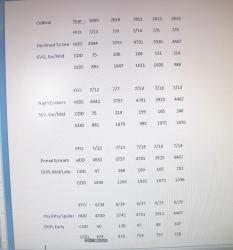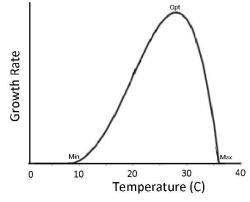Plants need a certain temperature to be reached before they can start to grow. Then, because they cannot regulate their temperature the speed at which they grow is determined by the temperatures they experience during each day and night (plus all sorts of other things such as the actual intensity of light, how they were fertilized, watered, etc). But what tends to be the most important is the temperature. Each plant species has its own "base" temperature - below that temperature it does not grow (or grows so slowly that it makes little visible growth). The base temperature for corn/maize (
Zea mays) is 50F; the base temperature for wheat is 32F; Many perennials are assumed to have a base temperature of 40F or 5C (which is 41F).
Since different species have different base temperatures, growing degree days (gdd) can be calculated with different bases. If my memory is serving me correctly I once calculated an approximate base temperature for daylilies as 42F so gdd that are calculated with base 40F or 5C should be ok.
Heating degree days are often calculated from a base temperature of 65F.
If the average temperature of a day is 65F then that day's hdd is 0 but its gdd (base 40) is 25. If the average temperature for a day is 40F then its hdd is 25 but its gdd is 0. If the average temperature for a day is 32F then its hdd is 33 but its gdd is 0. If the average temperature for a day is 73F then its hdd is 0 but its gdd is 33.
When the average daily temperature in a location is between the base temperature of hdd and the base temperature of gdd the two will be related, but outside of those temperatures they will not be related. Hdd may provide an estimate of the gdd in some locations for some periods of time but gdd should always be more accurate.
When one tries to use either gdd or hdd to calculate bloom time one needs to be sure that the start date used for the calculation is appropriate. Plants do not have a January 1 start date for their growth

It becomes difficult to pick the appropriate date to start accumulating gdd. A location may have 20 days of average temperatures above 40F and the daylilies start to grow but then one day of below 32F may knock their growth back and they have to start again when the temperatures rise above 40F. Or one day may actually have quite a high average temperature but its low was much below 32F and that set the plants back but is not visible in the simple gdds (one would have to look at the actual minimum temperatures rather than use the gdds calculated by locations such as the weatherunderground). So yes there are always other factors involved. Gdds are simply calculated from average daily temperatures, but those are not entirely accurate - a more accurate calculation would require hourly temperatures for each hour of every day and the appropriate equations relating growth to temperature for the particular plant species.
Bloom is starting about now in some parts of Florida, isn't it?
Earlier in this thread I indicated that there would be a general consistency to flowering dates but that many factors influence flowering. Two locations with exactly the same gdds will not necessarily have exactly the same FFO for the same cultivar. Even cloud cover can influence flowering date, along with all the plant 'nutrient' factors, etc. I have several clumps of the same cultivars planted at opposite ends of the rows in the same field. They never have FFO on the same day yet as far as I know there are no differences between their locations and the clumps are about the same sizes, etc.

